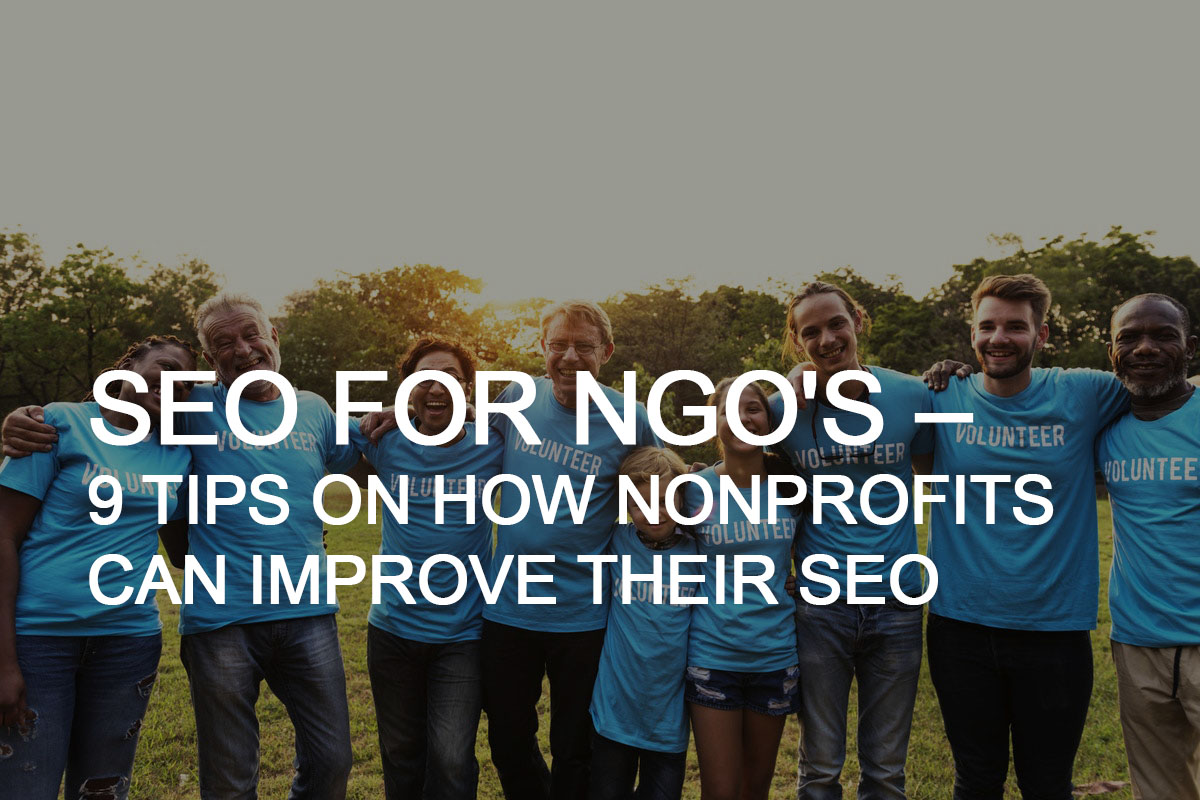Does site rank and organic search results from SEO searches really matter for nonprofits? Yes! That is, as long as you want people to know about your organization. And yes, nonprofit organizations do need to make a profit to stay in business. Without a viable website, traction and traffic, and people understanding your cause, how do you remain afloat? Although it’s not the first thing nonprofits think of, the right tactics for not for profit SEO, will greatly help improve your website rank, for the proper terms. So, where do you begin when it comes to increasing site rank?
Creating SEO-Optimized Content for NGOs
For NGOs, creating content that resonates with their audience while also being optimized for search engines is a balancing act of art and science. Without properly optimized content its nearly impossible to get the proper keywords added to your website. Here’s a guide on how NGOs can craft content that not only appeals to their audience but also ranks well in search engine results.
Understanding Your Audience
- Identify Your Core Audience: Understand who your primary audience is – donors, volunteers, beneficiaries, or the general public.
- Tailor Content to Their Interests: Create content that addresses the concerns, interests, and motivations of your audience segments.
Keyword Integration in Content
- Use Relevant Keywords: Incorporate keywords naturally into your content. These should be terms that your audience is likely to search for.
- Avoid Keyword Stuffing: Use keywords judiciously to avoid making your content feel forced or unnatural.
Crafting Engaging Blog Posts
- Choose Topics Wisely: Select topics that are not only relevant to your NGO’s mission but also of interest to your audience.
- Storytelling: Use real stories and case studies to make your content more engaging and relatable.
- Incorporate Visuals: Use images, infographics, and videos to make your blog posts more engaging and shareable.
Leveraging Social Media
- Platform-Specific Content: Tailor your content to suit the format and audience of each social media platform.
- Engage with Your Audience: Encourage interaction by asking questions, creating polls, and responding to comments.
- Use Hashtags Effectively: Utilize relevant hashtags to increase the visibility of your posts.
SEO for Different Types of Content
- For Blog Posts: Use a clear structure with headings and subheadings, and ensure that your blog posts are of a substantial length to cover the topic thoroughly.
- For Social Media: Focus on catchy headlines and engaging visuals. Use shorter, impactful messages tailored for quick consumption.
Regular Content Updates
- Keep Content Fresh: Regularly update your content to keep it relevant. This includes updating statistics, revising outdated information, and adding new insights.
- Repurpose Old Content: Transform successful blog posts into infographics, videos, or social media posts.
User Experience and Accessibility
- Easy-to-Read Format: Ensure your content is easy to read and accessible, with a clear font, well-spaced paragraphs, and a mobile-friendly layout.
- Alt Text for Images: Use descriptive alt text for images, which is beneficial for SEO and makes your content accessible to visually impaired users.
Call-to-Action
- Clear CTA: Include a clear call-to-action in your content, guiding readers on what to do next – whether it’s to donate, sign up as a volunteer, or share your content.
Monitoring and Analytics
- Track Performance: Use tools like Google Analytics to track how your content is performing. Look at metrics like page views, time spent on page, and social shares.
By following these guidelines, NGOs can create content that not only engages and informs their audience but also performs well in search engine rankings, helping them to reach a wider audience and achieve their mission more effectively.
Optimizing for Content Keywords
You have to optimize the content on your website with the right keywords. If you’re a nonprofit that helps animals, you obviously need to highlight your services
- Pet care
- Animal adoption
- Shelters
- Dogs, cats, etc
People who are searching for a nonprofit animal shelter, sitter, or other pet service provider, will search specific keywords, these are a few of the many you’re going to want to target in that niche. If those words aren’t on your site pages, titles, service description, or mission statement, where do you expect your site to rank?
Today, content is still king, and that doesn’t seem to be going away. Therefore, you need to create rich, engaging content, which is relevant and adds value to your target niche as a nonprofit. Google scans websites for proper keywords and local SEO use; make sure your site’s on point.
Incorporating a Detailed Keyword Strategy
To effectively optimize your NGO’s website for search engines, a detailed and well-thought-out keyword strategy is essential. Here’s how you can develop a robust keyword strategy tailored specifically for NGOs:
1. Understand Your Audience:
- Identify Your Audience: Understand who your audience is, what they care about, and the language they use.
- Audience Segmentation: Segment your audience based on their interests, demographics, and the type of engagement they have with your NGO (e.g., donors, volunteers, beneficiaries).
2. Use Keyword Research Tools:
- Google Keyword Planner: Start with Google Keyword Planner to find basic keywords related to your NGO’s mission and services.
- NGO-Specific Tools: Utilize tools like Moz, SEMrush, or Ahrefs to delve deeper into keyword research, focusing on terms that are relevant to the nonprofit sector.
- Long-Tail Keywords: Focus on long-tail keywords which are less competitive and more specific to your NGO’s niche.
3. Analyze Search Intent:
- Understand Intent: Differentiate between informational, navigational, and transactional search queries.
- Content Alignment: Align your content with the user intent behind each keyword. For instance, use informational keywords for blog posts and educational content.
4. Competitor Keyword Analysis:
- Identify Competitors: Look at other NGOs in your space and analyze the keywords they are ranking for.
- Gap Analysis: Use tools like SEMrush’s Keyword Gap tool to find opportunities where your competitors are ranking but you are not.
5. Local and Global Keywords:
- Local Keywords: If your NGO operates locally, include region-specific keywords in your strategy.
- Global Keywords: For NGOs with a global presence, consider broader keywords that appeal to an international audience.
6. Keyword Optimization:
- On-Page SEO: Incorporate your chosen keywords naturally into your website’s content, including titles, meta descriptions, and headers.
- Consistent Use Across Channels: Use your keywords consistently across all platforms, including social media, to strengthen your SEO.
7. Monitor and Adapt:
- Keyword Performance: Regularly monitor the performance of your keywords using tools like Google Analytics.
- Adapt Strategy: Be prepared to adapt your strategy based on performance data and changing trends in the NGO sector.
8. Integrate Keywords into Content Strategy:
- Content Planning: Plan your content calendar around your keyword strategy, ensuring that all major keywords are covered in your content.
- Quality Content: Remember, the key is not just to use keywords but to create high-quality, informative content that resonates with your audience and adds value.
9. SEO Tools for Nonprofits:
- Nonprofit Discounts: Look for SEO tools that offer discounts or special plans for nonprofits.
- Training and Resources: Utilize the training and resources many of these tools provide to stay updated on the best practices in SEO.
By implementing this detailed keyword strategy, your NGO can significantly improve its online visibility, attract more traffic to its website, and effectively engage with its target audience.
Titles and Meta Tags
Harping back on the point of keywords, make sure they’re in title tags, H1, H2, and H3 tags, and in your meta description. If people don’t see the words animal, shelter (or whatever other keywords are linked to your nonprofit) in the meta description, it isn’t going to rank highly on Google. In fact, it might not even rank on the top page of Google. Want an in-depth guide to title tags? Click here
In today’s digital landscape, having a strong online presence is crucial for NGOs. This requires not only a strategic approach to content and keywords but also a focus on technical SEO aspects. Here, we’ll delve into mobile optimization, page speed improvements, and the use of structured data, all of which are vital for enhancing an NGO’s website performance and search engine ranking.
Technical SEO for Charities and NGO’s
Technical SEO is the foundation of a website. If it’s not optimized for mobile, or loading fast it will offer a poor user experience. As a result of long waiting times and a poorly optimized page users will likely bounce off. Having a good technical foundation is nearly essential.
Mobile Optimization
In the digital era, where the majority of internet users access information via smartphones, it’s imperative for NGOs to prioritize technical SEO aspects to enhance their online visibility and user engagement.
-
Responsive Design:
- Ensure your website automatically adjusts its layout, images, and content to fit the screen size of various devices.
- Use a mobile-friendly theme if your website is built on a content management system like WordPress.
-
Mobile User Experience:
- Simplify navigation on mobile devices and ensure that buttons and links are easy to tap.
- Minimize pop-ups and intrusive interstitials that can hinder the mobile user experience.
-
Testing and Improvement:
- Regularly test your website on different mobile devices and browsers.
- Utilize Google’s Mobile-Friendly Test tool to identify areas for improvement.
Page Speed Improvements
In an online world where speed is king, optimizing your NGO’s website for faster load times is essential to retain visitor interest and improve search engine rankings.
-
Image Optimization:
- Compress images without losing quality to reduce load times.
- Use modern formats like WebP for better performance.
-
Minimize HTTP Requests:
- Reduce the number of elements (scripts, images, CSS files) that need to be loaded on each page.
-
Leverage Browser Caching:
- Store frequently accessed resources in the user’s browser to speed up subsequent page loads.
-
Use a Content Delivery Network (CDN):
- Distribute your content across multiple, geographically dispersed servers to reduce latency.
-
Optimize Server Response Time:
- Choose a reliable hosting provider and consider upgrading your hosting plan for better performance.
Structured Data
-
Schema Markup:
- Implement schema markup to help search engines understand the content and context of your pages.
- Use NGO-specific schemas like
NGO,NonProfit,Event, orDonateActionto highlight your organization’s activities and events.
-
Rich Snippets:
- Enhance your search results with rich snippets that provide more information to users, such as events, projects, or donation campaigns.
-
Tools for Implementation:
- Use tools like Google’s Structured Data Markup Helper and the Structured Data Testing Tool to implement and test your schema markup.
-
Regular Updates:
- Keep your structured data updated, especially for time-sensitive content like events or campaigns.
Continuous Monitoring and Updating
-
SEO Audits:
- Conduct regular SEO audits to identify and fix technical issues that could impact your search engine rankings.
-
Stay Updated:
- Keep abreast of the latest SEO trends and algorithm updates, as search engine algorithms are constantly evolving.
-
Analytics and Reporting:
- Use tools like Google Analytics to monitor your website’s performance and make data-driven decisions.
By focusing on these technical SEO aspects, NGOs can significantly improve their website’s usability, speed, and overall search engine performance. This not only helps in ranking higher in search results but also provides a better experience to visitors, increasing the likelihood of engagement and support for your cause.
Off Page and Building Backlinks for NGOs
Most businesses and nonprofits think that only what they’re doing matters if it is on their website. This isn’t true. Backlinks, guest blogs, review sites, and Google Business Profile pages, are some examples of off-page SEO. It’s important that what’s said and read about your site in these places, is accurate and adds value as well. It isn’t as important as on-page SEO, but it matters, and can lead to Google penalizing your ranking, if the off-page content is bad enough. In fact off-page SEO is (in our opinion) the number one factor when it comes to getting your content ranked.
1. Leveraging Partnerships for Backlinks
- Collaborate with Partner Organizations: Engage in content collaborations with partner NGOs, businesses, or academic institutions. This can include joint research studies, reports, or webinars.
- Shareable Content for Partners: Create content that is valuable for your partners and encourage them to link to it from their websites.
2. Guest Blogging
- Identify Relevant Blogs and Publications: Look for blogs, news sites, or online magazines that align with your NGO’s mission and audience.
- Pitch Compelling Content: Offer to write articles or blog posts that provide value to the host site’s audience. Ensure that these pieces naturally include a link back to your NGO’s website.
- Build Relationships with Editors and Bloggers: Foster ongoing relationships with key figures in relevant online communities for continued guest blogging opportunities.
3. Digital PR for NGOs
- Press Releases: Use newsworthy events, such as launching a significant project or a fundraising event, to create press releases that can be picked up by news websites.
- Media Outreach: Reach out to journalists and bloggers who cover topics related to your NGO’s activities. Provide them with unique insights, data, or stories.
- Online Interviews: Participate in online interviews or podcasts where you can discuss your NGO’s work and gain a backlink.
4. Utilizing Social Media
- Active Social Media Presence: Regularly post engaging content on social media platforms and include links to your website.
- Encourage Sharing: Create content that is likely to be shared by your followers, increasing the likelihood of gaining backlinks from various sources.
5. Community Engagement
- Forums and Online Communities: Participate in online forums and communities related to your NGO’s cause. Offer valuable insights and include a link to your website in your forum signature or profile.
- Answer Questions on Platforms like Quora: Provide expert answers to questions related to your NGO’s field on platforms like Quora, and include a relevant link to your website.
6. Creating Link-Worthy Content
- Develop Original Research and Data: Publish original research, surveys, or compelling data that others in your field will want to reference.
- Infographics and Visual Content: Create visually appealing infographics or videos that are likely to be shared and linked to by other websites.
7. SEO Tools for Backlink Analysis
- Use SEO Tools: Utilize tools like Ahrefs, SEMrush, or Moz to analyze your backlink profile and identify potential opportunities for new backlinks.
8. Monitoring and Outreach
- Track Mentions: Use tools to monitor the web for mentions of your NGO. Reach out to sites that mention you but do not link to your website, requesting them to add a link.
By implementing these strategies, NGOs can build a robust backlink profile that not only enhances their SEO but also broadens their reach and impact in the digital space.
Leveraging Local SEO for NGOs
Local SEO is crucial for NGOs, especially those that operate within specific communities or regions. It helps in making your NGO more visible to the local audience who are likely to engage with your cause. Here’s how NGOs can effectively leverage local SEO:
Understanding the Importance of Local SEO
- Local Relevance: Local SEO helps in connecting with community members who are most likely to engage with your NGO’s activities and events.
- Enhanced Visibility: By optimizing for local search, your NGO can appear in local search results and Google Maps, making it easier for people to find and connect with you.
Google Business Profile Optimization
- Claim and Verify Your Listing: Ensure that your NGO has a Google Business Profile and that it is verified. This is crucial for appearing in local search results and Google Maps.
- Complete and Accurate Information: Provide comprehensive and up-to-date information about your NGO, including the address, phone number, operating hours, and a link to your website.
- Regular Updates: Keep your profile updated with the latest events, news, or changes in your NGO.
- Encourage Reviews: Encourage volunteers, donors, and beneficiaries to leave reviews on your Google Business Profile. Respond to these reviews to show engagement.
Local Keyword Targeting
- Incorporate Local Keywords: Use keywords that include your city, region, or local landmarks in your website’s content, meta descriptions, and titles.
- Content Tailored to Local Audience: Create content that addresses local issues, events, or stories related to your NGO’s mission.
Local Link Building
- Collaborate with Local Businesses: Partner with local businesses for events or campaigns and earn backlinks from their websites.
- Local Media Outreach: Reach out to local newspapers, radio stations, and TV channels for coverage, which can lead to valuable local backlinks.
Utilizing Local Events and Activities
- Promote Local Events: Use your website and social media to promote local events, workshops, or fundraisers.
- Local Event Listings: List your events on local event websites and community calendars.
On-Page Optimization for Local SEO
- NAP Consistency: Ensure that your NGO’s name, address, and phone number (NAP) are consistent across your website and all online directories.
- Local Schema Markup: Implement local schema markup on your website to provide search engines with detailed local information about your NGO.
Engaging with the Local Community Online
- Social Media Engagement: Use social media to engage with the local community. Share local news, stories, and events that resonate with your audience.
- Local Forums and Groups: Participate in local online forums and groups to increase your NGO’s visibility and establish a local presence.
By focusing on these local SEO strategies, NGOs can significantly improve their visibility and engagement within their local communities, leading to increased support, participation, and impact in the areas they serve.
Incorporate URL Keywords
The same goes for your URL. It not only has to be easy to remember so people can visit frequently, it has to link to the keywords that surround your nonprofit organization and its mission (for example – www.pethelp.com/shelters). In this URL you can see the terms pet, shelter, care, and it immediately elicits animals and care to searchers. You want something easy to remember and memorable, and you want your URL to incorporate a relevant keyword related to your nonprofit.
Use Social Media
Social media should definitely be a part of your SEO strategy today. Add videos to YouTube about upcoming pet adoptions (for your pet/animal nonprofit). Add new photos of a facility you’re building on Instagram. Ask customers to take a poll on Facebook. Tweet new content, or information about new animals that are in shelter for adoption on Twitter (or anything relevant to your nonprofit organization).
Social media allows for engagement, and today, social media greatly impacts your rank for Google organic searches. Make sure you’re engaging, and incorporate links for your social media channels, directly onto your website, as this will increase internal linking, and more visits to your sites/platforms.
Remain Abreast on New Trends
In the world of SEO algorithms are changing daily. Today, https (vs http) is important. Encrypting your site for security, having a mobile first index, and AMP (accelerated mobile pages) is of high importance. But, tomorrow these might not be as important as proper keyword targeting. As a nonprofit, you either have to build a strategy that allows you to change your SEO and content, or have to work with an SEO company that will research trends and changes, to ensure you’re site is highly visible, at all times, to searchers.
Conclusion
These are some of the many practices (in no particular order), you’ll want to employ when building an SEO strategy as a nonprofit organization. These not for profit SEO tactics will not only help increase visibility for more keywords within your niche, but also help increase overall rank for multiple searches through Google’s organic results pages.
Without the community we would not exist. We look for ways to give back and be apart of the community. If you are a registered not for profit group contact a member of our team to receive exclusive discounts and media coverage services not otherwise offered. For more information check out our managed SEO services!





